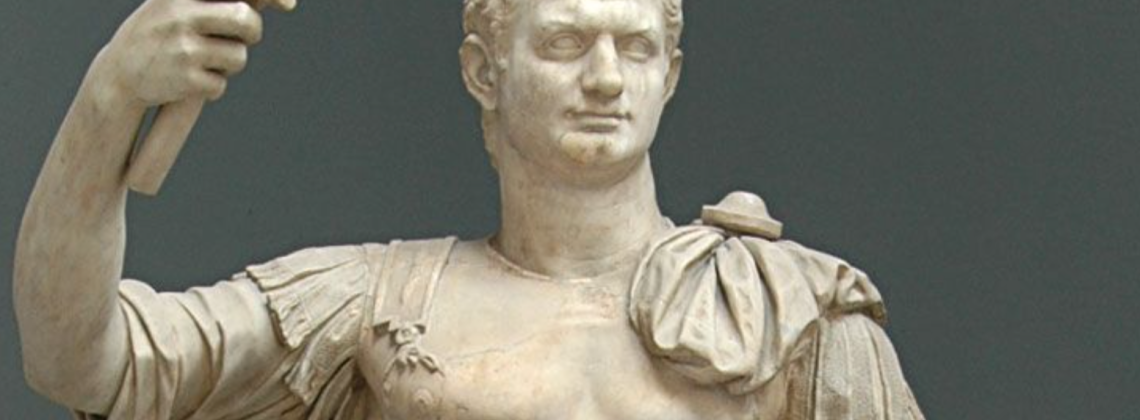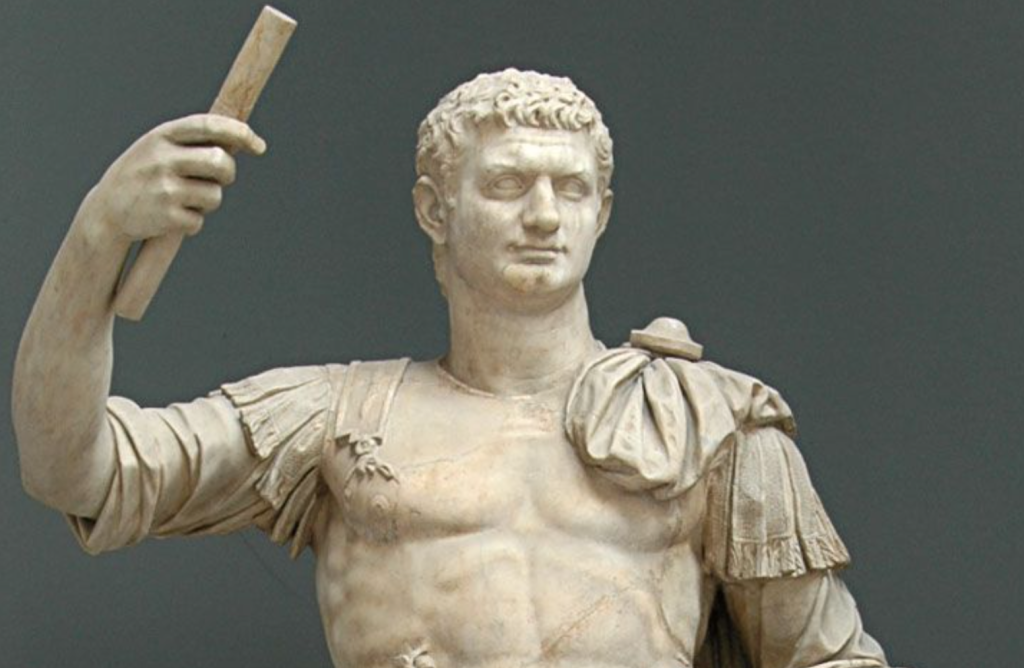

The imperial center of Rome remained stable for two centuries. How?
Emperor of Rome: Ruling the Ancient Roman World by Mary Beard. Liveright, 2023. 512 pp., $39.99
Gold Flake and Innocence were the two man-eating pet bears of Valentinian I, Roman emperor in the later fourth century. According to the historian Ammianus Marcellinus, Valentinian’s contemporary, the two bears resided in cages near the emperor’s bedroom. When Innocence had demonstrated her value with years of faithful service, she was released into the woods, for what the emperor intended to be a much-deserved sylvan retirement. Since Innocence spent most of her life in captivity and was not accustomed to hunting for her own food, the retirement was likely a very short one. What happened to Gold Flake we do not know.
Valentinian’s two bears do not appear in Mary Beard’s latest book, Emperor of Rome: Ruling the Ancient Roman World. Beard is one of the most well-known Roman historians writing for the general audience. Her new book examines 221 years of Roman autocracy, from Augustus to the teenager Alexander Severus. Emperors after Alexander Severus’s murder in AD 235 are not included on the grounds that the emperorship after that point was fundamentally a different beast—later emperors, for instance, were frequently drawn from ranks of the military, often hailed from the Balkans, and were eventually Christianized and elevated above their subjects by elaborate court ceremonies. Gold Flake and Innocence thus fall outside of the chronological limits of the book.
Nevertheless, colorful details like Gold Flake and Innocence abound in the 400+ pages of Beard’s book. The reader encounters the emperor Domitian writing a book on hair care, the emperor Augustus housing a paleontological collection at his Capri villa, Augustus’s daughter Julia having “maximum fun for maximum offense” by having frequent sex on the rostra in the Forum, and the emperor Caligula parading imitation Germans in a triumph by taking some Gauls, dying their hair red, and teaching them a smattering of German. The book is a lively survey of the role of the emperor in the Roman world. The reader learns how succession functioned, how emperors dined, where they lived, who the people surrounding them at court were, what emperors did “on the job” and off, what emperors did on tour in the provinces, how they were portrayed in art both large and small, and finally, how their deaths and deifications proceeded.
A key theme is the fakery of autocracy. Statues convince the public that homely emperors are perfect (or, in Vespasian’s case, very precisely imperfect) physical specimens. The same statues convince emperors themselves that they are indeed the men at the top. A wax model of a dead emperor celebrates a triumph for an already obsolete victory. On his deathbed, Augustus asks those around him whether he played his part well, like an actor in a play. The lines between truth and useful lies constantly waver, whether at state dinners or at the Colosseum. “Autocracy,” Beard says, “upturns the ‘natural’ order and replaces reality with sham, undermining your trust in what you think you see.”
Beard is concerned with finding moral lessons, namely concerning the causes and effects of autocracy, but is careful not to find those in the past “guilty of the crime of simply not being like us.”
While moral judgments are relatively restrained in her story, aesthetic ones predominate. Claudius makes “a rather feeble in-joke.” Dissenting senators are the “awkward squad.” The poem that Hadrian composed for his favorite horse is simply “too much.” Marcus Aurelius’ Meditations are essentially greeting card platitudes, while Pliny the Elder is “an even more ponderous moralizer than his nephew.” Galen, in contrast, is “one of the best-kept secrets of classical literature.”
In one such judgment, Beard come down hard on the poet Martial. Concerning the poet’s depiction of a reenactment of the bandit Laureoleus’s death, she writes, “It is hard to know now which is the more distasteful: the sadistic violence itself or the aestheticization of it in Martial’s celebratory verse.” Beard’s appraisal brings to mind a joke that comedian Norm Macdonald made in conversation with Jerry Seinfeld:
Norm Macdonald: You know, Patton Oswalt said, “the worst thing about the Bill Cosby thing is the hypocrisy of it all . . .” and I disagree.
Jerry Seinfeld: And you disagree?
Norm: I thought the worst part was the raping.
Beard’s quips combine with an informal style, minimal Latin, and references kept to an appendix on “Further Reading” to place the book in the category of popular history, along the lines of Beard’s SPQR: A History of Ancient Rome and, to a lesser extent, Twelve Caesars: Images of Power from the Ancient World to the Modern. As a work of popular history, the book is engaging and rich in vivid detail, from the architecture of imperial estates to the funerary inscriptions of imperial freedmen.
While Beard has focused on public scholarship more recently, she made a name for herself for her scholarship on Roman religion, and the discussion of religion and the emperorship is particularly strong. The book is organized thematically rather than chronologically, as Beard explores the emperor at dinner, the emperor in his palace, the emperor abroad, and so forth. Why this thematic treatment? For Beard, it is because the nature of the emperorship is essentially static for over two centuries.
As Beard notes, “Between the reign of Augustus and Alexander Severus, the stability of Roman politics and geopolitics meant that you could have gone to sleep in, for example, 1 BCE and woken up two hundred years later and still have recognized the world around you.” The question remains: Why did the role of the emperor and the world around him change so little before Alexander Severus’ murder?
Beard suggests that it was partly through the collaboration of thousands of people ranging from high-ranking senators to slaves working in the imperial kitchens. These people accepted that system and perpetuated it. “It was not violence or the secret police, it is collaboration and cooperation—knowing or naïve—well-meaning or not—that keep autocracy going.”
Was collaboration sufficient? Beard cautiously offers it only as a partial explanation. So why did the empire of Augustus look so similar to that of Alexander Severus? This is the most intriguing question the book raises.
Some part of a solution might reside in the Roman Empire’s antiquarianism, its deference to the customs of the ancestors, and the powerful pull of earlier role models, which play an underpowered role in Emperor of Rome. The discussion of the emperor Hadrian’s relationship with the city of Athens, for example, does not bring in the city’s earlier dealings with the dynasts of the Hellenistic Eastern Mediterranean. The Ptolemies of Egypt and Attalids of Pergamon had given benefactions to the city, which built monuments in their honor. The Seleucid king Antiochus IV Epiphanes had tried to finish construction on the massive Temple of Olympian Zeus, which Hadrian finished three centuries later. Hadrian’s actions at Athens were self-aggrandizing to be sure, but they were part of a tradition that had centuries-deep roots in the city. Likewise, Alexander the Great is only rarely mentioned, despite his standing as the ultimate role model for rulers and generals in the ancient Mediterranean. Claudius’s more niche emulation of the Roman king Numa, too, might have been an interesting addition.
In a world where Roman officers dressed as if they were serving in Alexander’s army and priests sang hymns so archaic that they were no longer comprehensible, it would not be surprising to find Roman rulers—and the courtiers and palace freedmen who advised them—going back to the same autocratic models again and again (the Persian king Cyrus, the Macedonian Alexander, and the Romans Augustus and Trajan). Deifications of dead emperors helped signal which emperors were worthy of emulation. The sameness of the emperorship over time thus might have something to do with a distinctly Roman obsession with emulation of past models and a distrust of outright innovation.
Yet antiquarianism and a constant looking to the past are also insufficient explanations by themselves since these forces were present after AD 235 as well. More explanations might be offered: the economic realities of the empire, assassination’s check on imperial excess or innovation, the empire’s delegation of so much administration to local elites, or simply the efficacy of the empire at delivering peace to its inhabitants.
A more convincing explanation for the static nature of the emperorship from 27 BC–AD 235 probably cannot be made without a fuller comparison with the period after 235—the age of soldier-emperors from the Balkans, Christianity, and a more autocratic government. Why and how the world of Augustus, Trajan, and Marcus Aurelius changed into that of Constantine, Valentinian, and Theodosius could illuminate why the earlier system was so surprisingly unchanging. A sequel to Emperor of Rome, besides giving some of the spotlight to Innocence and Gold Flake, could also get further to the core of the nature of Roman autocracy.
Was it a combination of fakery and collaboration, as Beard suggests? The natural result of civil war? The triangulation of a culture both intensely hierarchical and distrustful of hereditary monarchy? The Roman emperorship is a vibrant and multifaceted subject for anyone interested in the nature of power and autocracy, and Beard’s book offers a thoroughly engaging and thought-provoking introduction to its world.
Carolynn Roncaglia is Associate Professor of Classics at Santa Clara University. She is the author of Northern Italy in the Roman World: From the Bronze Age to Late Antiquity.